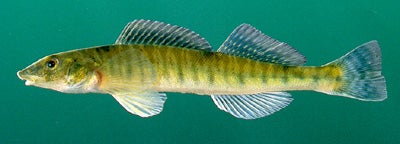LOGPERCH
SCIENTIFIC NAME: Percina caprodes
CHARACTERISTICS: The logperch, of the subgenus Percina, is one of the largest and most distinctive darters. Individuals have a conical snout that projects well beyond the upper jaw, a wide frenum, obvious tigerlike vertical banding along the sides, and a single black spot at the base of the caudal fin. The back has 16 to 22 narrow bands that vary in intensity and width; some resemble saddles and continue downward toward the venter. The body is yellowish brown to yellow-green along the back and sides, changing to light green to white on the venter. The uncolored caudal and dorsal fins contain light basal and marginal black bands while breeding males have dusky membranes on the dorsal fins. Percina caprodes is similar to P. burtoni, P. austroperca, the “Mobile logperch,” and the “Gulf logperch,” and is distinguished from these species by its spiny dorsal fin with no orange or red banding. See Rafinesque (1818b) for original description.
ADULT SIZE: 3.9 to 5.9 in (100 to 150 mm)
DISTRIBUTION: Percina caprodes is distributed from Hudson Bay southward to western tributaries of the lower Mississippi River basin and eastward to the Tennessee River drainage in Alabama. The subspecies Percina c. caprodes occurs throughout the Tennessee River drainage in Alabama, where it is widespread and occasionally abundant (Morris and Page, 1981).
HABITAT AND BIOLOGY: We have collected this species in a variety of habitats, ranging from small tributaries to large rivers and impoundments. Individuals usually occur over sand and gravel in streams with a moderate current or over sand and mud substrates in lakes, sometimes at great depths. Spawning occurs from March to May. Females bury from 10 to 20 eggs per spawn in sand or gravel substrates of riffles or shoals (Winn, 1958a, b). We have observed large spawning aggregations of logperch in the free-flowing reaches of large streams upstream of reservoirs. Logperch live three to four years (Thomas, 1970) and young logperch feed on small crustaceans, while adults consume midge larvae, mayflies, and caddisflies. This and other logperch species flip stones scattered along the bottom in search of food. With age, their snouts often become blunt and calloused.
ORIGINAL DESCRIPTION: Rafinesque described the logperch in 1818.
ETYMOLOGY:
Percina is a diminutive of Perca, meaning perch.
Caprodes means piglike, in reference to the distinctive snout of this species.
The copyrighted information above is from Fishes of Alabama and the Mobile Basin.






